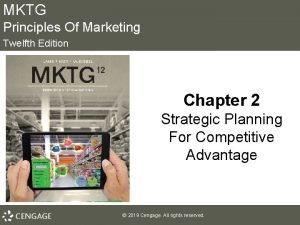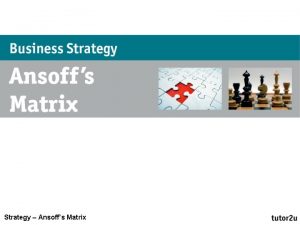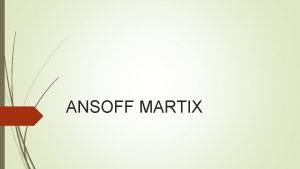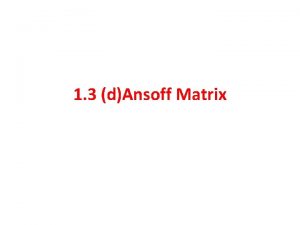ANSOFF MATRIX Introduction The Ansoff Matrix is a








- Slides: 8

ANSOFF MATRIX

Introduction � The Ansoff Matrix is a strategic planning tool that provides a framework to help executives, senior managers, and marketers devise strategies for future growth. It is named after Russian American Igor Ansoff, an applied mathematician and business manager, who created the concep

Growth strategies Ansoff, in his 1957 paper, provided a definition for product-market strategy as “a joint statement of a product line and the corresponding set of missions which the products are designed to fulfil”. [3] He describes four growth alternatives for growing an organization in existing or new markets, with existing or new products. Each alternative poses differing levels of risk for an organization:

Market penetration In market penetration strategy, the organization tries to grow using its existing offerings (products and services) in existing markets. In other words, it tries to increase its market share in current market scenario. This involves increasing market share within existing market segments. This can be achieved by selling more products or services to established customers or by finding new customers within existing markets. Here, the company seeks increased sales for its present products in its present markets through more aggressive promotion and distribution. [citation needed] This can be accomplished by: Price decrease Increase in promotion and distribution support Acquisition of a rival in the same market Modest product refinements This is the least risky growth option.

Market development In market development strategy, a firm tries to expand into new markets (geographies, countries etc. ) using its existing offerings and also, with minimal product/services development. This can be accomplished by: Different customer segments Industrial buyers for a good that was previously sold only to the households; New areas or regions of the country Foreign markets. This strategy is more likely to be successful where: The firm has a unique product technology it can leverage in the new market It benefits from economies of scale if it increases output The new market is not too different from the one it has experience of The buyers in the market are intrinsically profitable. This additional quadrant move increases uncertainty and thus increases the risk

Product development In product development strategy, a company tries to create new products and services targeted at its existing markets to achieve growth. This involves extending the product range available to the firm's existing markets. These products may be obtained by: Investment in research and development of additional products; Acquisition of rights to produce someone else's product; Buying in the product and “badging” it as one’s own brand; Joint development with ownership of another company who need access to the firm's distribution channels or brands. This also consists of one quadrant move so is riskier than Market penetration and a similar risk as Market development.

Diversification In diversification an organization tries to grow its market share by introducing new offerings in new markets. It is the most risky strategy because both product and market development is required. Related Diversification— there is relationship and, therefore, potential synergy, between the firms in existing business and the new product/market space. Concentric diversification, and (b) Vertical integration. [clarification needed] Unrelated Diversification: This is otherwise termed conglomerate growth because the resulting corporation is a conglomerate, i. e. a collection of businesses without any relationship to one another. A strategy for company growth by starting up or acquiring businesses outside the company’s current products and markets. Diversification consists of two quadrant moves so is deemed the riskiest growth option.

Uses The Ansoff Matrix is a useful tool for organizations wanting to identify and explore their growth options. Although the risk varies between quadrants, with Diversification being the riskiest, it can be argued that if an organization diversifies its offering successfully into multiple unrelated markets then, in fact, its overall risk portfolio is lowered














